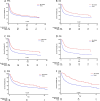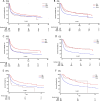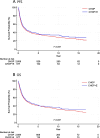Real-world data on long-term outcomes in patients with T-cell lymphomas: a nationwide study of Korea
- PMID: 40839148
- PMCID: PMC12370571
- DOI: 10.1007/s44313-025-00095-1
Real-world data on long-term outcomes in patients with T-cell lymphomas: a nationwide study of Korea
Abstract
Background: Peripheral T-cell lymphomas (PTCLs) are a rare and heterogeneous group of aggressive malignancies. This study aimed to comprehensively analyze patients diagnosed with PTCLs in Korea, evaluating treatment outcomes, including transplantation and long-term survival.
Patients and methods: In this retrospective study, clinical data from the National Health Insurance Service on patients with PTCL were investigated. Most patients diagnosed with mature T-cell lymphomas and natural killer (NK)/T-cell lymphomas between January 2005 and December 2022 in Korea were included. Incidence rates of each subtype and survival outcomes of both treated and untreated patients were analyzed.
Results: A total of 12,573 patients were analyzed. PTCL not otherwise specified (PTCL-NOS) and extranodal NK/T-cell lymphoma were the most frequently diagnosed, followed by angioimmunoblastic T-cell lymphoma (AITL). Compared to the general population, the relative survival rate was highest in anaplastic lymphoma kinase (ALK)-positive anaplastic large cell lymphoma. With a median follow-up of 6.7 years, the 3-year and 5-year progression-free survival (PFS) rates among treated patients were 44.0% and 39.5%, while the overall survival (OS) rates were 48.6% and 43.5%, respectively. Kaplan-Meier survival curves indicated that patients who added etoposide to the CHOP (cyclophosphamide, doxorubicin, vincristine, and prednisone) regimen showed improved PFS and OS. In addition, autologous stem cell transplantation significantly improved PFS and OS, particularly in the PTCL-NOS and AITL subtypes.
Conclusion: Patients who received etoposide-containing CHOP-based regimens had improved treatment outcomes. The survival benefits of consolidative autologous stem cell transplantation (auto-SCT) were evident in PTCL-NOS and AITL.
Keywords: Chemotherapy; Lymphoma; Stem cell transplantation; Survival; T-cell.
© 2025. The Author(s).
Conflict of interest statement
Declarations. Ethics approval and consent to participate: All procedures involving human participants in this study were conducted in accordance with the ethical standards of the institutional and/or national research committee, as well as the 1964 Declaration of Helsinki and its later amendments or comparable ethical standards. Competing interests: The authors declare no competing interests.
Figures



Similar articles
-
Epidemiology, clinical features, and outcomes of peripheral T-cell lymphoma in Latin America: an international, retrospective, cohort study.Lancet Haematol. 2025 Apr;12(4):e258-e268. doi: 10.1016/S2352-3026(25)00011-0. Epub 2025 Mar 5. Lancet Haematol. 2025. PMID: 40056928
-
Nivolumab in patients with relapsed or refractory peripheral T-cell lymphoma: modest activity and cases of hyperprogression.J Immunother Cancer. 2022 Jun;10(6):e004984. doi: 10.1136/jitc-2022-004984. J Immunother Cancer. 2022. PMID: 35750419 Free PMC article. Clinical Trial.
-
Impact of SCHOLAR-1 Criteria on Chimeric Antigen Receptor T Cell Therapy Efficacy in Aggressive B Lymphoma: A Real-World GELTAMO/GETH Study.Transplant Cell Ther. 2023 Dec;29(12):747.e1-747.e10. doi: 10.1016/j.jtct.2023.08.026. Epub 2023 Sep 1. Transplant Cell Ther. 2023. PMID: 37659694
-
Optimisation of chemotherapy and radiotherapy for untreated Hodgkin lymphoma patients with respect to second malignant neoplasms, overall and progression-free survival: individual participant data analysis.Cochrane Database Syst Rev. 2017 Sep 13;9(9):CD008814. doi: 10.1002/14651858.CD008814.pub2. Cochrane Database Syst Rev. 2017. PMID: 28901021 Free PMC article.
-
Chimeric antigen receptor (CAR) T-cell therapy for people with relapsed or refractory diffuse large B-cell lymphoma.Cochrane Database Syst Rev. 2021 Sep 13;9(9):CD013365. doi: 10.1002/14651858.CD013365.pub2. Cochrane Database Syst Rev. 2021. PMID: 34515338 Free PMC article.
References
-
- Zain JM, Hanona P. Aggressive T-cell lymphomas: 2021 updates on diagnosis, risk stratification and management. Am J Hematol. 2021;96(8):1027–46. - PubMed
-
- Ellin F, Landström J, Jerkeman M, Relander T. Real-world data on prognostic factors and treatment in peripheral T-cell lymphomas: a study from the Swedish Lymphoma Registry. Blood. 2014;124:1570–7. - PubMed
LinkOut - more resources
Full Text Sources
Research Materials

